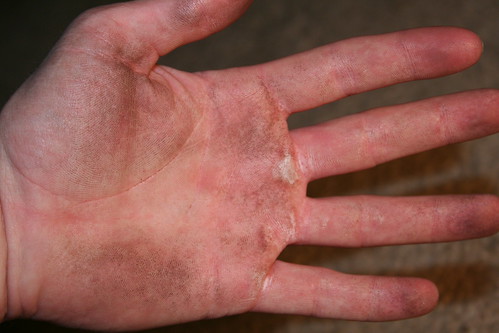In various times and in various ways there have been abuses, wrongs and misunderstandings in the Church. One such misunderstanding could be that priests are so sacred, and their hands having been anointed so absolutely sacred, that they ought to do no profane thing. Now, I think this is an extreme position that hardly anyone holds, but there are some that might come close to it. There is a saying out there among some that priests' hands are for "chalices, not calluses."
hands are for "chalices, not calluses."
I think this misunderstanding can arise only in a very particular place and time. First, they have to be very ignorant of the monastic life lived even today by Benedictines, Carmelites, Carthusians and the several other communities of religious (though, I do acknowledge that the more laborious jobs are usually left to the lay members and the priests often devote themselves more to prayer and study). Second, I doubt that for much of the Church's history, it was even possible for priests to get by without doing physical labor - around the rectory, travelling from here to there (perhaps even on horseback), fixing the Church, etc... Third, I also doubt that many priests in rural areas find themselves in a situation where they need not do any serious or physical labor simply because it's far more economical for them to fix problems themselves. But, maybe I'm wrong.
If I wanted to, I think I could build up a theological argument based upon the three munera of the priesthood of Christ and show how such understandings are wrong, but no, my purpose is far more simple. No, I mean only to tell you that I had to clean up a spill last week.
Here at St. Pius X in Rochester, our washing machine for laundry drains into a big tub-sink in the basement. They built it this way because there was only one drain and it was far cheaper to have the washer drain into the tub than to fix another drain or arrange for both washer and sink to empty in the same drain. Well, as occasion would have it, I didn't notice that there was a rag left in the sink and so when the washing machine dumped several gallons of water in to the tub-sink, the rag lifted up off the bottom and then was sucked into the drain and plugged it. So, "my tub overflowethed."
I attempted not to curse my own thoughtlessness (I had seen the rag there, but thought nothing of it); I also tried not to curse the rag. But, when I had finished soaking up all the water off the cement floor, I was displeased to walk out of the room and see that the water had made it to the carpet in the next room over. Nevertheless, I reluctantly thanked God and went and grabbed the towel to continue soaking up the mess. All-in-all, the job was done within an hour. Thankfully, no blisters resulted. Frankly, I couldn't care less if I end up with callused hands, but a little mopping up of water isn't going to give me calluses anytime soon.


5 comments:
Deacon,
I can fully attest that priests in rural areas - and we have a lot of them in the Diocese of Saint Cloud - use their hands for both chalices and calluses. I have found it not at all unusual to find a parish priest in rural areas fumbling through a toolbox trying to fix this-and-that around the parish.
I have many fun memories from my youth of seeing my small-town parish priest trying to 1) secure a firebox to a wall, 2) fix the squeeky balcony floor and, more amusingly, 3) fix the Church's elevator unit.
Interestingly, this priest was sucessful in all but one of the above endevors . . .
I've done a few things around the church this summer, mostly cleaning up the rectory because the pastor's vision is poor and he can't see the mess. (No, really). But I have managed to install new headlight housings, a new water pump (with great difficulty), new coolant, new oil, and new paint on the bumpers on my truck. Definitely keeping my hands dirty here.
I have a question, are the Carthusian monks related at all to the Cartharist heresy of one god of the old and a another one for the new. This was the one instance where church "banned" a translation ogf bible. Any connection?
The Cathari, for the most part, were started around the 11th century. These held for a strong dualism of all that exists; more explicitly, they believed there was an ultimate good principle which existed alongside an ultimate evil principle--both being co-equal. Both of these contributed to the creation of the world, but the good principle could not create anything quite simply "good;" there was always evil mixed in with it. A more expansive essay can be found here.
The Carthusians are completely separate. They were founded by Saint Bruno in, coincidentally, the 11th century. St. Bruno repeatedly avoided being named bishop by fleeing to the desert, and eventually built a following. The Carthusian Order, which St. Bruno's following eventually became, had long time been a group of hermits. They maintain some of that life yet today. Their American monastery's website can be found here.
Thank you Deacon. That helps alot. They just sounded alike so I got confused.
Post a Comment
Note: Only a member of this blog may post a comment.